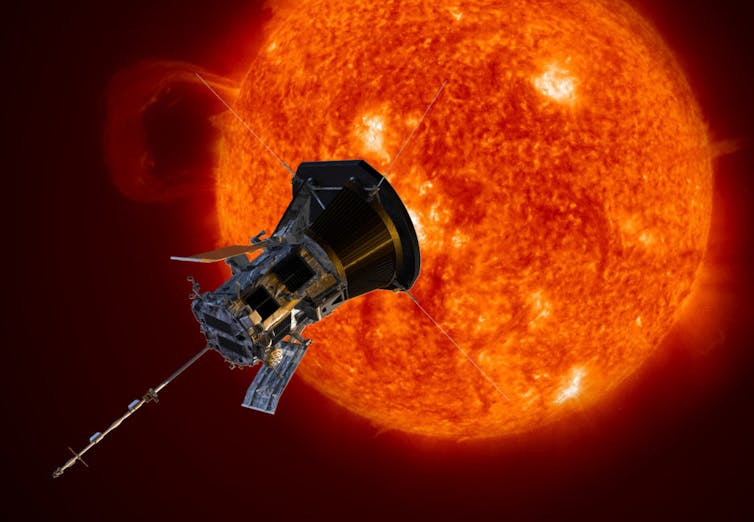
If you ask a child to paint a picture of the sun, you will most likely get a bright yellow circle on a piece of paper. This is actually quite accurate, given that the sun is a ball of hot gas and that its surface (called the photosphere) mostly shines in bright yellow light. The yellow colour is determined by the temperature of the photosphere, which is about 5,500°C.
In fact, the sun sometimes looks pretty much exactly like a child’s drawing. During a solar eclipse, the sun’s outer atmosphere, called the solar corona, can actually be seen as a bright circle, with the moon blocking the rest of the sunlight. Like the sun below, the corona consists of plasma – a gas of charged particles. About 80 years ago, scientists found that the temperature of the solar corona is actually much hotter than the surface, at a few million degrees celsius. This discovery has puzzled the field of solar physics ever since.
Also read: When ISRO Isn’t Enough, There’s Another Place You Can Go to Find Out More
The high temperatures of the corona cause it to expand into space as a continuous outflow of plasma called the solar wind. But how the sun accelerates this wind is another giant mystery. Luckily, NASA’s Parker Solar Probe has recently achieved a close encounter with the sun and is starting to answer these and many other questions – with its first results just published in a series of papers in Nature (see here, here, here and here).
Where nobody has gone before
The first ideas for a mission to uncover the mysteries of the sun date back to the 1950s. But the harsh environment near the sun turned out to be too challenging for spacecraft technologies back then.
In 2018, NASA finally launched the Parker Solar Probe to pursue this early dream. Its orbit will bring the spacecraft closer and closer to the sun over the coming years. At its closest encounter in 2024, it will be just over six million kilometres away from the sun. Although this number still sounds quite large, it is much closer to the sun than any spacecraft has ever been before. For comparison, the Earth orbits the sun at a distance of 150 million kilometres.

The instruments on the spacecraft directly measure the solar-wind plasma and the electromagnetic fields around the spacecraft. The spacecraft also measures energetic particles, which are ions (atoms that have lost electrons) or electrons that travel much faster than the solar wind. The probe even has an imaging instrument onboard that takes photographs of the corona.
First results
The Parker Solar Probe’s first measurements show that variations in the wind’s speed and in the magnetic field are much greater than observed near Earth. For example, the magnetic-field sensors detected large flips in the direction of the magnetic field.
We have no idea what these “switchbacks” really are. But the measurements show that they coincide with increases in the speed of the solar wind flowing away from the sun. This happens through short and strong “jets” – increases in the flow speed of the solar wind with a duration of just a few minutes.
The exact nature of the magnetic switchbacks and jets is certainly a puzzle that we must resolve in the future. They are so intensive that they may actually be a major factor in driving the acceleration of the solar wind.
Also read: Autonomous Agency Under PMO Mooted to Harness Potential of Indian Geospatial Industry
The instruments on the probe also detected many smaller fluctuations in the electromagnetic fields. Like the switchbacks, we have known about their existence from previous measurements, but their intensity near the sun is really surprising. This suggests they may actually have an important role in the heating of the solar corona as well as accelerating the solar wind.
Another interesting finding came after the occurrence of a solar flare – a bright eruption of ultraviolet radiation in the corona. The probe’s detectors measured particles that had been accelerated in an active region in the corona. The timing of the arrival of these particles revealed that they had travelled for a long distance from the sun than expected. Since the energetic particles follow magnetic field lines from the sun, this long travel time suggests that the magnetic field has more structure between the sun and the probe than previously thought.
The imaging instrument also saw signatures of coronal mass ejections near the sun. These are large eruptions of material that originate in the solar corona. The study of these eruptions is quite important for our society. If a large coronal mass ejection hits the Earth, it can cause a lot of disruption, such as power outages, loss of GPS signals, interruptions of radio communication and harm for air travellers and astronauts.
Even after the probe’s first results, many questions remain open. However, going closer to the sun has already shown to be absolutely worth it. In the coming years, the spacecraft will go even closer – and I’m sure its modern instruments will enable numerous new scientific discoveries.
Those of us working in the field are very excited about the prospect that these measurements will soon help us crack the biggest mysteries of the sun – why the solar corona is so hot and how the solar wind is accelerated.
Daniel Verscharen, Senior Research Fellow of Plasma Physics, UCL
This article is republished from The Conversation under a Creative Commons license. Read the original article.

